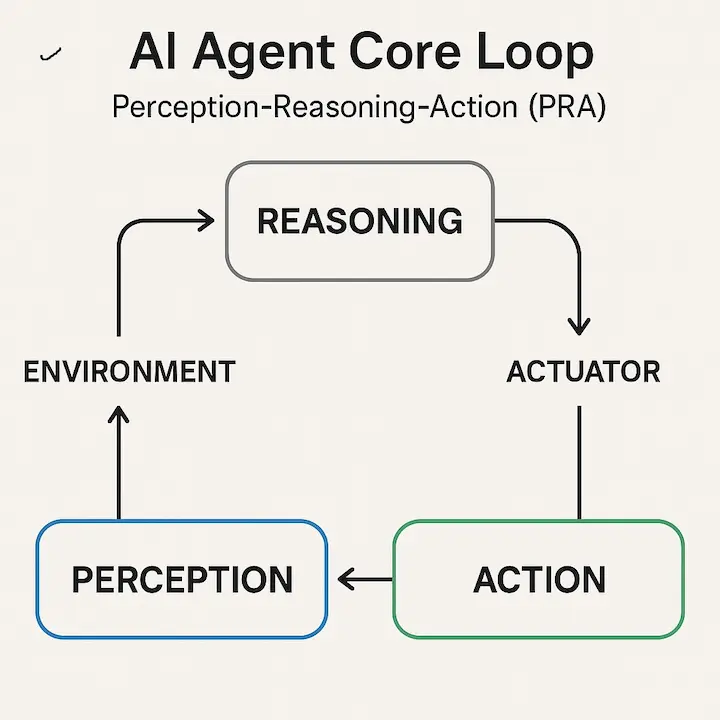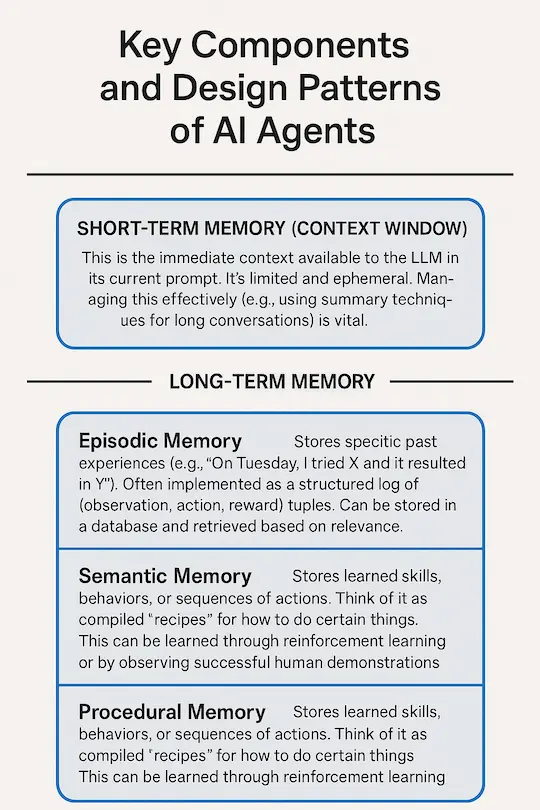AI Agents Explained: Perception, Reasoning, Action & Architecture
An AI agent is a system that perceives its environment through sensors, processes that information (often using the neural networks you know), makes decisions, and then acts upon its environment through actuators. The key differentiating factors for an agent are:
- Autonomy: They operate without constant human intervention.
- Goal-Oriented: They have a defined objective they strive to achieve.
- Adaptability: They can learn and adjust their behavior based on experience and environmental feedback.
The Core Loop: Perception-Reasoning-Action (PRA)
At the heart of almost every AI agent is this continuous cycle:

1. Perception:
- What it is: The agent gathers information from its environment. This can be anything from text, images, sensor readings, API responses, or even internal system states.
How your existing knowledge applies:
- NLP (Transformers/RNNs): For text-based environments (e.g., interacting with a user via chat, reading documents, scraping web pages), your knowledge of Transformers (BERT, GPT, etc.) and RNNs (LSTMs, GRUs) is directly applicable. These models process raw text into meaningful embeddings or representations that the agent's reasoning component can use.
- Computer Vision (CNNs/Transformers): If the agent interacts with visual data (e.g., a robot navigating a room, an image analysis agent), CNNs (for feature extraction) and vision transformers are crucial for perceiving objects, scenes, and their relationships.
- Sensor Data: For agents interacting with the physical world (robotics, IoT), this involves processing numerical data from sensors (temperature, pressure, lidar, etc.). Simple feedforward networks or even specialized RNNs for time-series data might be used here.
What are the practical Implications?
- Data Preprocessing: Raw sensory data often needs cleaning, normalization, and feature engineering before being fed into your models.
- APIs and Web Scraping: For software agents, perception often involves calling APIs (e.g., weather API, stock market API) or scraping information from websites. Libraries like requests and BeautifulSoup in Python are commonly used.
- Context Window: For LLM-based agents, the "perception" is often within the context window of the LLM. The challenge is managing and filtering what information gets fed into this limited window to keep the agent focused and efficient.
2. Reasoning (The "Brain"):
- What it is: The agent processes its perceptions, accesses its memory, and decides on the next course of action to achieve its goal. This is where the "intelligence" truly manifests.
How your existing knowledge applies:
- Large Language Models (LLMs - often Transformer-based): Modern AI agents heavily leverage LLMs as their core reasoning engine. The LLM can interpret natural language prompts, generate internal thoughts, decompose complex tasks into sub-tasks, and select appropriate tools.
- Fine-tuning/Prompt Engineering: While you might not fine-tune a massive LLM from scratch, prompt engineering is critical. Crafting effective prompts to guide the LLM's reasoning, encourage specific outputs (e.g., JSON for tool calls), and facilitate self-correction is a key skill.
- Reinforcement Learning (RL): For agents learning optimal policies through trial and error (e.g., in complex environments like games or robotics), RL algorithms (Q-learning, A2C, PPO) are used. The neural network (often a feedforward or actor-critic network) within the RL agent learns the policy.
What are the practical Implications?
- Prompt Chaining/Orchestration: Complex reasoning often involves a series of prompts and responses from the LLM, effectively creating a "chain of thought." Frameworks like LangChain, LlamaIndex, and CrewAI facilitate this by providing structured ways to define these chains, manage state, and handle tool calls.
-
Reasoning Patterns:
- ReAct (Reason + Act): A popular pattern where the LLM interleaves reasoning (thoughts) with actions (tool calls). The agent explicitly outputs its thought process, then the action it wants to take, and then observes the result, allowing for self-correction.
- Tree of Thoughts (ToT): Extends ReAct by exploring multiple reasoning paths (like a search tree) and evaluating their potential. This can lead to more robust solutions but is computationally more expensive.
- Reflection/Self-Correction: Agents can be prompted to "reflect" on their previous actions and their outcomes, identifying errors or inefficiencies and adjusting their future behavior. This involves feeding the LLM its past actions and observations and asking it to critique itself.
- Planning Algorithms: Beyond just LLM-driven reasoning, classical AI planning algorithms (e.g., A*, STRIPS) can be integrated, especially for highly structured environments where optimal sequences of actions can be formally defined. The LLM might generate the high-level plan, and a classical planner refines the low-level steps.
-
Knowledge Bases/Retrieval Augmented Generation (RAG):
To overcome the LLM's knowledge cutoff and provide up-to-date or
domain-specific information, agents use RAG. This involves:
- Storing external knowledge (documents, databases) in vector databases.
- Using embeddings (from models like BERT or specialized embedding models) to convert queries and documents into numerical vectors.
- Performing vector similarity search to retrieve relevant chunks of information.
- Augmenting the LLM's prompt with this retrieved information, allowing it to reason over external facts.
3. Action (The "Hands"):
The agent executes its decided actions in the environment.
- Function Calling/Tool Use: This is a critical component for LLM-based agents. The LLM is trained (or prompted) to output a structured format (e.g., JSON) that describes a function call and its arguments. This function call then triggers an external tool or API.
- Robotics/Physical Actuation: For physical agents, this involves sending commands to motors, grippers, or other effectors. This often requires control systems that translate abstract commands into precise physical movements.
What are the practical Implications?
-
Tools/APIs: Agents gain their real-world utility by
using tools. These can be:
- Web Search: (e.g., Google Search API, Brave Search) for accessing real-time information.
- Code Interpreters: (e.g., Python interpreter) for executing code, performing calculations, data analysis, or interacting with local files.
- External APIs: Any third-party service (CRM, email, calendar, payment gateways, e-commerce platforms).
- Custom Functions: Any specific function you write for the agent to perform.
- Tool Orchestration: The agent needs to decide when to use a tool, which tool to use, and what arguments to pass. This is often driven by the LLM's reasoning process.
- Error Handling: Robust agents need to handle errors from tool executions (e.g., API rate limits, invalid inputs) and feed these observations back into the reasoning loop for re-planning or retry.
Key Components and Design Patterns of AI Agents

Memory Systems
Crucial for maintaining context and learning over time. Unlike a stateless Transformer inference, agents need memory.
- Short-Term Memory (Context Window): This is the immediate context available to the LLM in its current prompt. It's limited and ephemeral. Managing this effectively (e.g., using summary techniques for long conversations) is vital.
-
Long-Term Memory: For retaining information across
sessions or for extended periods.
- Episodic Memory: Stores specific past experiences (e.g., "On Tuesday, I tried X and it resulted in Y"). Often implemented as a structured log of (observation, action, reward) tuples. Can be stored in a database and retrieved based on relevance.
- Semantic Memory: Stores general factual knowledge, concepts, and rules. This is often embodied in a knowledge graph or a vector database with general information. RAG systems play a big role here.
- Procedural Memory: Stores learned skills, behaviors, or sequences of actions. Think of it as compiled "recipes" for how to do certain things. This can be learned through reinforcement learning or by observing successful human demonstrations.
Implementation:
- Vector Databases (e.g., Pinecone, Weaviate, ChromaDB): Store embeddings of past interactions or knowledge, allowing for semantic search and retrieval of relevant memories.
- Traditional Databases (SQL/NoSQL): For structured logs of events or facts.
- Graph Databases (e.g., Neo4j): For representing complex relationships in semantic memory.
Learning Mechanisms
- Reinforcement Learning from Human Feedback (RLHF): This is the bedrock of powerful LLMs. Humans rate model outputs, and these ratings are used to train a reward model, which then guides the LLM's fine-tuning. For agents, this means humans providing feedback on agent performance, leading to better decision-making.
- Self-Correction/Reflection: As mentioned, the agent can analyze its own failures and successes, updating its internal "beliefs" or refining its prompts for future attempts.
- Learning from Examples: Providing demonstrations of desired behavior (e.g., few-shot prompting) can significantly improve an agent's ability to perform tasks.
- Experiential Learning: The agent continuously updates its internal model of the world and its strategies based on the outcomes of its actions. This is often framed as updating a mental model or knowledge base.
Multi-Agent Systems
- Collaboration: Different agents, each specialized in a particular task or domain, can communicate and share information to achieve a common goal. This mirrors distributed computing or human teamwork.
- Hierarchy: A supervisor agent can delegate tasks to sub-agents, orchestrating complex workflows.
- Specialization: One agent might be a "researcher," another a "planner," and another an "executor," each leveraging different tools and knowledge bases.
- Communication Protocols: Designing how agents communicate (e.g., shared memory, message passing, common language) is crucial.
Practical Implementation & Frameworks
Building AI agents from scratch can be complex. Several frameworks simplify the process:
-
LangChain: A popular Python framework for developing
LLM-powered applications. It provides modules for:
- Models: Integrating with various LLMs.
- Prompts: Managing and composing prompts.
- Chains: Sequencing LLM calls and other components.
- Agents: The core agentic loop, including tool use and memory.
- Memory: Various memory types (conversational, episodic, etc.).
- Tools: Pre-built and custom tool definitions.
- LlamaIndex: Focuses more on data indexing and retrieval for RAG. Excellent for building agents that need to query large, external knowledge bases efficiently.
- CrewAI: Specializes in orchestrating multi-agent systems, defining roles, tasks, and collaboration.
- AutoGen (Microsoft): Another powerful framework for multi-agent conversations and collaboration, allowing agents to write and execute code, and self-correct.
When you're building:
- Define Clear Goals: The agent needs a well-defined objective. Ambiguous goals lead to poor performance.
- Tool Design: Design your tools thoughtfully. Each tool should have a clear purpose, defined inputs, and expected outputs. The LLM's ability to understand and use these tools depends heavily on their clear definition (often through Pydantic models for type hinting).
- Observation Loop: How will the agent "observe" the outcome of its actions? This feedback loop is essential for learning and correction.
- Guardrails and Safety: Important for preventing agents from performing undesirable actions (see ethical considerations below).
Challenges and Ethical Considerations
- Hallucination/Factuality: LLMs can generate plausible but incorrect information. RAG helps, but it's not a complete solution. Agents need robust ways to verify facts.
- Reliability and Robustness: Agents can be brittle. Small changes in prompt or environment can lead to unexpected behavior. Extensive testing and failure analysis are crucial.
- Computational Cost: Running complex agentic loops with multiple LLM calls and tool executions can be expensive and slow. Optimization is key.
- Infinite Loops: Agents can sometimes get stuck in repetitive reasoning or action cycles. Mechanisms for detecting and breaking these loops are necessary (e.g., iteration limits, dynamic prompt adjustments).
-
Safety and Alignment: Ensuring agents act in a way
that is beneficial and aligned with human values.
- Bias: Inherited from training data or algorithmic design. Careful data curation and fairness metrics are needed.
- Transparency and Explainability (XAI): Understanding why an agent made a particular decision can be difficult ("black box" problem). Designing agents to provide transparent reasoning steps (like ReAct's thought process) helps.
- Accountability: Who is responsible when an autonomous agent makes a mistake or causes harm? This is a legal and ethical challenge.
- Deception and Manipulation: Agents could be designed (intentionally or unintentionally) to mislead or manipulate users. Clear disclosure of AI interaction and ethical guidelines are paramount.
- Misuse: The power of autonomous agents could be misused for malicious purposes.